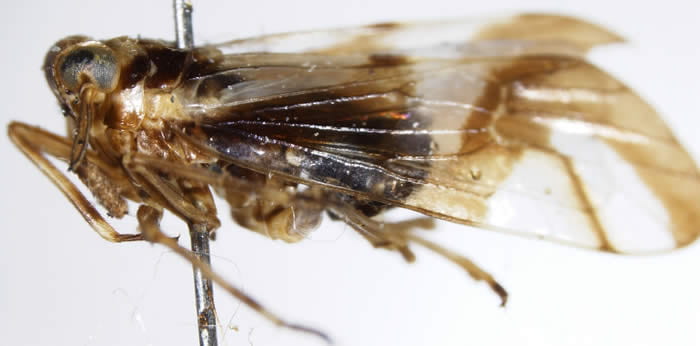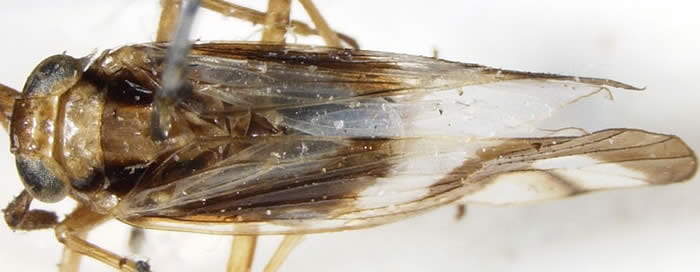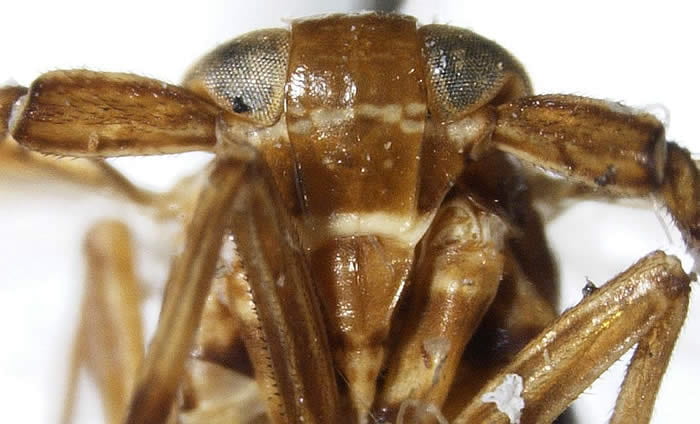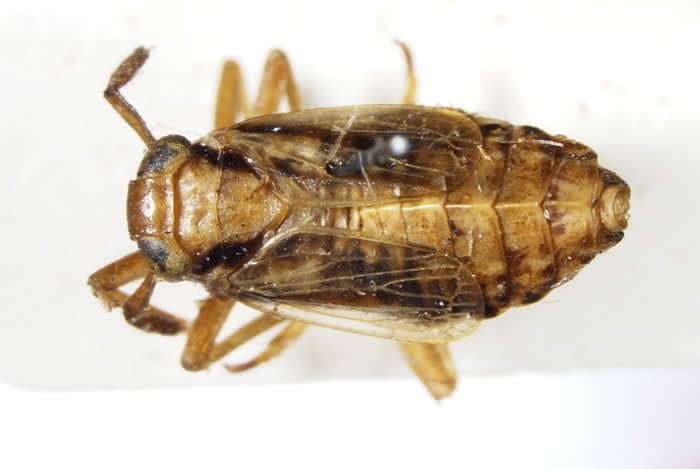[Back to Higher classification of Delphacidae]
Contents
Family Delphacidae Leach, 1815
Subfamily Delphacinae Leach, 1815
Tribe Delphacini Leach, 1815
Genus Delphax Fabricius, 1798: 511
Type species (in original combination) Cicada crassicornis Panzer, 1796: 19
Synonyms
= Araeopus Spinola, 1839: 336 (type species Cicada crassicornis Panzer, 1796: 19, see ICZN, 1961: 246).
Note1: Delphax is the type genus of the family Delphacidae.
Note2: Delphax Fabricius, 1798, was given priority over Delphax Walbaum, 1792 (I think here) (Mammalia, a dolphin) by ICZN, 1961 (opinion 602). In short, Walbaum was providing an overview (quoting) Klein 1744, which is not available from the standpoint of nomenclature, and the ruling was, in effect, that quoting Klein 1744 (apparently this guy, but maybe not this work) did not make it available. Until this was decided, the Delphacidae had been given the name Araeopidae.
Distribution
Palearctic, except for 3 misplaced New World species, one species reported from Africa, and one species from China.
Recognized species
(distribution information may be incomplete)
A total of 15 species are currently placed in the genus, although some additional problematic taxa may be placed in Delphax.
New World: All New World Delphax are placed in the wrong genus.
Delphax conspersinervis (Lethierry, 1890) – Venezuela
= Araeopus conspersinervis Lethierry, 1890: 151.
= Delphax conspersinervis (Lethierry, 1890); comb. by Crawford, 1914: 577; Muir 1926: 37; Metcalf 1943: 378.
Delphax producta Walker, 1851: 353 – Jamaica
= Delphax producta Walker, 1851.
= Araeopus productus Walker, 1851; comb. by Metcalf, 1943: 384; restored to Delphax by implication ICZN, 1961.
Delphax setosus (Germar, 1830) – Brazil
= Asiraca setosus Germar, 1830: 57.
= Araeopus setosus (Germar, 1830); comb. by Schaum, 1850 69.
= Delphax setosus (Germar, 1830); by implication ICZN, 1961: 246.
Old World
Delphax alachanicus Anufriev, 1970 – China (Alashan Desert) (Mongolia)
Delphax angulicornis (Latreille, 1807) [Metcalf 1943: 377] – Africa
Delphax armenicus Anufriev, 1970 – Armenia, Greece, Ukraine
Delphax crassicornis (Panzer, 1796: 19) – Widespread (Austria, Azerbaijan, Belgium, Bulgaria, Czech Republic, Denmark, Estonia, Finland, France, Germany, Greece, Hungary, Italy, Japan, Kazakhstan, Kyrgyzstan, Lithuania, Netherlands, Poland, Romania, Russia, Spain, Sweden, Tajikistan, Tunisia, Ukraine, Yugoslavia)
Delphax (Araeopus) dorsatus Melichar, 1905: 285 [Metcalf 1943: 383]. This is now in Perkinsiella (Fennah 1969: 35).
Delphax inermis Ribaut, 1934 – Afghanistan, Algeria, Cyprus, France, Greece, Iran, Israel, Italy, Morocco, Spain, Tunisia
Delphax maritima Anufriev, 1977 – Japan (Hokkaido, Honshu); Russia (Primorye), Mongolia
Delphax meridionalis (Haupt, 1924) – Greece, Italy, Yugoslavia
Delphax narbonensis Ribaut, 1934 – France
Delphax orientalis (Linnavuori, 1955) – Turkestan, Kazakhstan, Kirghizia, Turkmenia
= Araeopus orientalis Linnavouri, 1955
= Delphax orientalis (Linnavouri, 1955); comb. by Dlabola, 1961: 268.
Delphax pakistanica Mushtaq, 1998 – Pakistan
Delphax pulchellus (Curtis, 1833) – Widespread in Europe, Russia
Delphax ribautianus Asche et al. 1982 – France, Greece, Italy, Yugoslavia
Fossil
Delphax rhenana† Statz, 1950 (Germany)
Delphax senilis† Scudder, 1877 (USA: Colorado)
Note: Delphax is the oldest genus name in Delphacidae, and many species were initially described in the genus, then subsequently moved elsewhere. FLOW and Fauna Europaea retain some species in Delphax not listed here – generally because their original combination is in this genus – that I place elsewhere following the genus-level placement used in Metcalf (1943). These taxa are obscure names whose current placement is incertae sedis (or nomen dubium). Frequently, the type material is either not diagnostic or lost (or occasionally simply not studied).
At any rate, here are the doubtful names listed in FLOW or Fauna Europaea. It should be understood that neither Delphax nor their current placement are likely valid (distributions from Metcalf, 1943).
FLOW
Delphax horvathi Lallemand, 1925: 6 [in Araeopus in Metcalf 1943: 383]; to Euidella by Fennah 1969: 25 (by implication to Euides)
Delphax gilveola Kirschbaum, 1868: 37. – Metcalf 1943: 451 placed this species in Delphacodes. (Austria, Germany, Turkmenistan)
Delphax hemiptera Germar, 1818: 217 – Metcalf 1943: 452 placed this species in Delphacodes. (Sweden, British Isles, Ireland, Germany, Latvia, Netherlands, USA: Alaska [error])
Delphax macroptera Costa, 1834: 85 – Metcalf 1943: 467 placed this species in Delphacodes. (Italy)
Delphax substitua Walker, 1851: 354 – Placed in Pissonotus by Fennah, 1967: 77; excluded from Pissonotus by Bartlett & Deitz (2000), currently incertae sedis. (Galapagos: Charles Island)
Delphax tapina Fieber, 1866: 528 – Metcalf 1943: 519 placed this species in Delphacodes. (France, Sardinia, Denmark)
Delphax tenae (Muir, 1926: 34) – This entry in FLOW is in error, this species was described in Delphacodes, as noted in Metcalf 1943: 520; this species is known to me and will be properly placed in time). (Ecuador)
Fauna Europaea (new link) – has some useful comments on some of these species
Delphax gilveola – see above
Delphax hemiptera – see above
Delphax macroptera – see above
Delphax modesta Fieber 1866: 526 – Metcalf 1943: 469 placed in Delphacodes. (France)
Delphax radiata Costa 1834: 84 – Metcalf 1943: 502 placed in Delphacodes. (Italy)
Delphax stigmaticalis Curtis 1837: 657 – Metcalf 1943: 512 placed in Delphacodes. (Great Britain, Ireland)
Delphax tapina – see above
Delphax uncinata Fieber 1866: 524 – see comment at Fauna Europaea (currently in Delphacissa Kirkaldy, 1906). (Spain, British Isles, Greece, England, Portugal, Scotland, Hungary)
Plant associations
Delphax species in the strict sense are Phragmites (common reed) feeders; also reported from Giant Cane (Arundo).
Recorded from Phragmites: D. armenicus, D. crassicornis, D. inermis, D. meridionalis, D. pulchellus, and D. ribautianus.
Recorded from Arundo: D. inermis, D. meridionalis, and D. ribautianus.
Economic Importance
Giant Cane and Common Reed are important invasive species in the New World.
Recognition
No photos of the putative New World Delphax are available (and the generic placement of these species is doubtful). Delphax are large delphacids with patterned wings and long, flattened antennae, primarily Paleartic. See keys in Holzinger et al. (2003) or Anufriev & Emeljanov (1988).
Delphax crassicornis (det Wagner; photos by Kimberley Shropshire, Department of Entomology, University of Delaware).
Delphax maritima from Mongolia (Courtesy Riley Nelson, BYU)
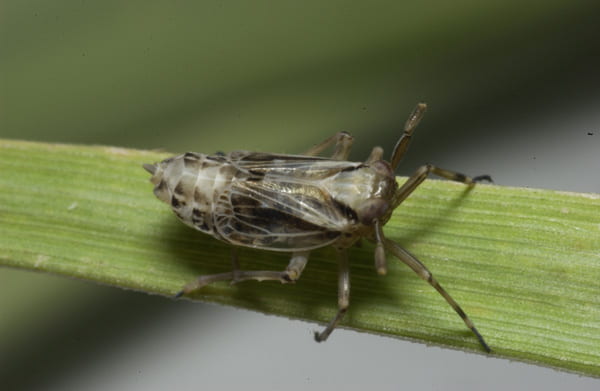
MONGOLIA: Khovsgol Aimag: Khotol Soum Orkhan Gol River, 15 km NW of Orkhan, N 49.16354úE 105.18880ú 739 msl 26 July 2005 C. R. Nelson# 8260 & SRP crew, see CRN 8170 notes.
Hemiptera: Homoptera: Auchenorrhyncha: Delphacidae: Delphax on Phragmites.
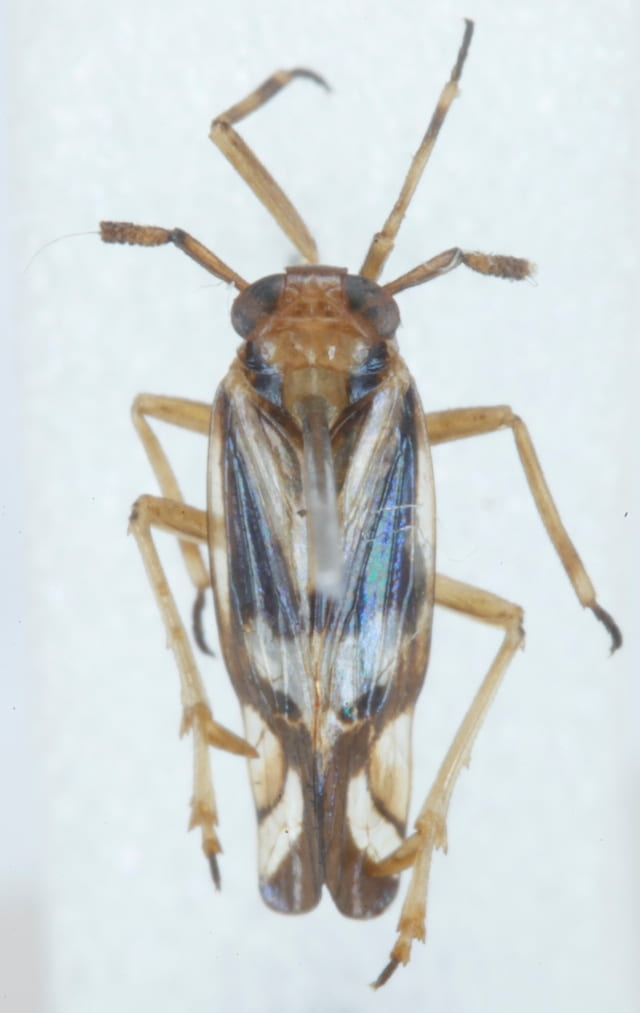
Delphax Delphax crassicornis CC BY-NC Marko Mutanen 2015 on BOLD.
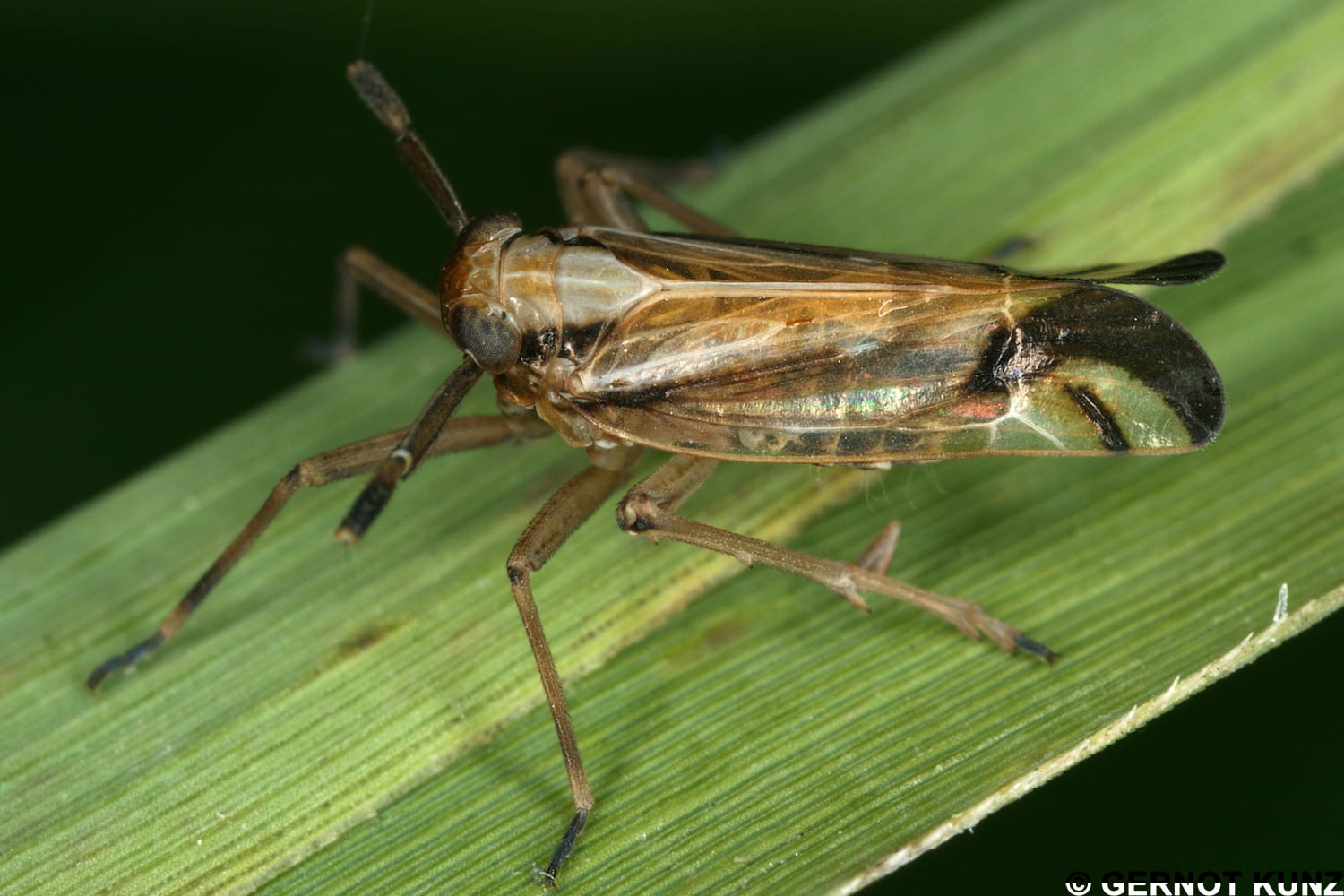
Delphax ribautiana Asche & Drosopoulos from FLOW by Gernot Kunz.
Online resources
TaxonPages.
iNaturalist.
EOL
FLOW
Discover Life
DEpository (Metazoa of Germany) (4 species listed, 2 valid)
British Bugs (Delphax pulchellus)
Fauna Europaea (new link)
Molecular resources
Genbank has for Delphax inermis and D. orientalis. Delphax orientalis was sequenced for 4 genes (18S rDNA, 28S rDNA, wingless, and cytochrome oxidase I) by Urban et al. (2010). Bold has limited data on D. orientalis and D. crassicornis .
Selected references
Anufriev, G.A. 1970. Two new Palaearctic species of Delphax Fabricius, 1798 (Homoptera, Delphacidae). Bulletin de l’Academie Polonaise des Sciences cl. II 18(4):201-205.
Anufriev, G.A. 1977. Delphacids (Homoptera, Auchenorrhyncha) of the Kurile Islands fauna. Zoologicheskii Zhurnal 56(6): 855-869 [859].
Asche, M. 1982. Beitrage zur Delphaciden-Fauna der Turkei (Anatolien) (Homoptera Cicadina Delphacidae) in Marburger Entomologische Publikationen 1(7): 71-98.
Anufriev, G.A. & A.F. Emeljanov. 1988. Volume II: Homoptera and Heteroptera. In: P.A. Lehr (ed.). Keys to the Insects of the Far East of the USSR in Six Volumes, Transliteration of the Russian title: Opredelitel’ nasekomykh Dal’nego Vostoka SSSR v shesti tomakh. Vol. 2. Ravnokrylye i poluzhestkokrylye. In: P.A. Lehr (ed.). Keys to the Insects of the Far East of the USSR in Six Volume. Nauka, Leningrad. [English translation] (Link to PDF here).
Asche, M. & S. Drosopoulos. 1982. Wer ist Delphax meridionalis (Haupt, 1924) (Homoptera Cicadina Delphacidae)? Marburger Entomologische Publikationen 1(6): 9-34.
Bartlett, C.R. & L.L. Deitz. 2000. Revision of the New World delphacid planthopper genus Pissonotus (Hemiptera: Fulgoroidea). Thomas Say Publications in Entomology: Monographs.
Bonfils, J. & W. Della Giustina. 1978. Inventaire et repartition biogeographique des Homopteres Auchenorhynques de Corse in Bulletin de la Societe entomologique de France 83: 23-29.
Costa, O.G. 1834. Enumeratio insectorum rariorum quae per Apuliam, Agrum Puteoloanum, Insulas Prochitate et Pithecusiae ac in monte Vesevo perlegi, anno 1834. Cenni zoologici, ossia descrizione sommaria delle specie nuove di animali discoperti in diversi contrade del regno nell’anno 1834 1834: 69-80.
Crawford, D.L. 1914. A contribution toward a monograph of the homopterous insects of the family Delphacidae of North and South America. Proceedings of the United States National Museum 46: 557-640, plus 6 plates.
Curtis, J. 1833. Asiraca. British Entomology; being illustrations and descriptions of the genera of insects found in Great Britain and Ireland: containing coloured figures from nature of the most rare and beautiful species, and in many instances of the plants …they are found. 10 (Plate): 445.
Curtis, J. 1837. Delphax. British entomology; being illustrations and descriptions of the genera of insects found in Great Britain and Ireland: containing coloured figures from nature of the most rare and beautiful species, and in many instances of the plants …they are found. 14 (Plate): 657.
D’Urso, V. 1995. Homoptera Auchenorrhyncha in In: Checklist delle specie della Fauna Italiana 42: 1-35.
Dlabola, J. 1961. Die Zikaden von Zentralasien, Dagestan und Transkaukasien (Homopt. Auchenorrhyncha). Acta Faunistica Entomologica Musei Nationalis Pragae 34 (587): 241-358.
Drosopoulos, S., M. Asche & H. Hoch. 1983. Contribution to the planthopper fauna of Greece. Homoptera, Auchenorrhyncha, Fulgoromorpha, Delphacidae). Annales de l’Institute phytopathologique Benaki (N.S.) 14: 19-68.
Fabricius, J.C. 1798. Supplementum Entomologiae Systematicae. 1798: 511-524.
Fennah, R.G. 1944. Nomenclatural notes on Lanternaria L., Fulgora L and Delphax, Fabr. Proceedings of the Biological Society of Washington 57: 43-44.
Fieber, F.X. 1866. Grundzüge zur generischen Theilung der Delphacini. Verhandlungen der Kaiserlich-Königlichen Zoologisch-botanischen Gesellschaft in Wien16: 517-534. [Delphax tapina, Delphax uncinata]
Gębicki, C., D. Świerczewski & J Szwedo. 2013. Planthoppers and Leafhoppers of Poland (Hemiptera: Fulgoromorpha et Cicadomorpha). Systematics, Check-list, Bionomy. The Monograph. Annals of the Upper Silesian Museum, Entomology 21-22: 1-245.
Germar, E.F. 1818. Bemerkungen über einige Gattungen der Cicadarien. Magazin der Entomologie 3: 177-227.
Germar, E.F. 1830. Species Cicadarium enumeratae et sub genera distributae. Thon’s Entomologisches Archiv 2(2): 1-8 [i.e. 37-44], 45-57.
Gunthart, H. & R. Muhlethaler. 2002. Provisorische Checklist der Zikaden der Schweiz (Insecta: Hemiptera, Auchenorrhyncha). Denisia 04, zugleich Kataloge des OO. Landesmuseums, Neue Folge, 176: 329-338.
Haupt H. 1924. Alte und neue Homoptera Mitteleuropas. Konowia. Zeitschrift für systematische Insektenkunde (mit Ausschluss von Coleopterologie und Lepidopterologie) unter Mitwirkung führender Entomologen. Wien 3: 285-300.
Hayashi, M. & S. Fujinuma. 2016. Part Fulgoromorpha. p. 323-355. In: Entomological Society of Japan 2016 – Catalogue of the insects of Japan. Volume 4 Paraneoptera (Psocodea, Thysanoptera, Hemiptera), 4. Editorial Committee of Catalogue of the Insects of Japan.
Holzinger, W. E., I. Kammerlander & H. Nickel. 2003. Fulgoromorpha, Cicadomorpha excluding Cicadellidae. Volume 1. The Auchenorrhyncha of Central Europe. Brill Academic Publishing, Leiden, Netherlands.
ICZN (International Commission on Zoological Nomenclature). 1961. Opinion 602. Delphax Fabricius, 1798 (Insecta, Hemiptera); Interpretation under the plenary powers. Bulletin of Zoological Nomenclature 18(4): 246-248.
Kirschbaum, C.L. 1868. Die Cicadinen der gegend von Wiesbaden und Frankfurt A. M. nebst einer anzahl neuer oder Schwer zu unterscheidender Arten aus anderen Gegenden Europa’s Tabellarisch Beschrieben. Jahrbücher des Vereins für Naturkunde im Herzogthum Nassau. 21: 1-202.
Lallemand, V. 1925. Hemiptera Homoptera. In: Zoological results of the Swedish Expedition to Central Africa 1921. Insecta. Arkiv for Zoologi. Utgifvet af K. Svenska Vetenskaps-akademien 18: 1-8.
Latreille, P.A. 1804. Division seconde. Famille quarante-huitieme. Cicadaires; cicadariae. in Histoire naturelle, generale particuliere des Crustaceset des Insectes, 12: 5-424. [Asiraca grisea Latreille, 1804]
Latreille, P.A. 1807. Sectio secunda. Familia quarta. Cicadariae. Cicadaires. Genera Crustaceorum et Insectorum secundum ordinem naturalem in familias disposita, iconibus exemplisque plurimis explicata 3: 1-258.
Lauterer, P. 1980. New and interesting records of leafhoppers from Czechoslovakia (Homoptera, Auchenorrhyncha) in Acta Musei Moraviae 65: 117-140.
Leach, W.E. 1815. Entomology. The Edinburgh Encyclopedia 9: 57-172.
Lethierry, L.F. 1890. Voyage de M. E. Simon au Venezuela (Décembre 1887-avril 1888) 9e mémoire Hémiptères Homoptères. Annales de la Société entomologique de France (6) 10:147-160; separate paged 1-14.
Linnavouri, R. 1955. On some Palaearctic Hemiptera. Annales Entomologici Fennici 21(1): 25-26.
Melichar, L. 1905. Beitrag zur Kenntnis der Homopterenfauna Deutsch-Ost-Afrikas. Wiener Entomologische Zeitung 24(9+10): 279-304.
Melville, R.V. 1960. Report of the generic name Delphax Fabricius, 1798 (Class Insecta, Order Hemiptera) with proposals for its validation under plenary powers. Bulletin of Zoological Nomenclature 17: 163-169.
Metcalf, Z.P. 1943. General Catalogue of the Hemiptera. Fascicle IV, Fulgoroidea, Part 3, Araeopidae (Delphacidae). Smith College, Northhampton, Massachusetts. (Delphax entry syn. of Araeopus, p. 372).
Mozaffarian, F. & M. R. Wilson. 2011. An annotated checklist of the planthoppers of Iran (Hemiptera, Auchenorrhyncha, Fulgoromorpha) with distribution data. ZooKeys 145: 1-57.
Muir, F.A.G. 1926. Contributions to our knowledge of South American Fulgoroidea (Homoptera), Part I. The family Delphacidae. Report of work of the Experiment Station of the Hawaiian Sugar Planters’ Association. Division of Entomology bulletin. 18: 1-51.
Mushtaq, S. 1998. Description of a new species of genus Delphax (Delphacidae: Homoptera) from Pakistan. Pakistan Entomologist 20(No. 1/2): 51-52.
Nast, J. 1972. Palaearctic Auchenorrhyncha (Homoptera). An annotated check list in Polish Scientific Publishers, Warszawa, 550 pp.
Nast, J. 1987. The Auchenorrhyncha (Homoptera) of Europe in Annales Zoologici Warszawa 40: 535-661.
Nickel, H. 2003. The Leafhoppers and Planthoppers of Germany (Hemiptera, Auchenorrhyncha): patterns and strategies in a highly diverse group of phytophagous insects in Pensoft Series Faunistica No. 28, Sofia-Moscow, Keltern, 1-460.
Ossiannilsson, F, 1978. The Auchenorrhyncha (Homoptera of Fennoscandia and Denmark. Part 1: Introduction, infraorder Fulgoromorpha in Fauna Entomologica Scandinavica 7 (1): 1-222
Panzer, G. W. 1796. Cicada crassicornis, Cicada dubia. Faunae Insectorum Germanicae initia: oder Deutschlands Insectem. 35: 19-20.
Panzer, G. W. 1796. Cercopis dionysii. Faunae Insectorum Germanicae initia: oder Deutschlands Insectem 34: 24.
Remane, R. & W. Frohlich. 1994. Vorlaufige, kritische Artenliste der im Gebiet der Bundesrepublik Deutschland nachgewiesenen Taxa der Insekten-Gruppe der Zikaden (Homoptera Auchenorrhyncha) in Marburger Entomologische Publikationen 2(8): 189-232.
Ribaut, H. 1934. Nouveaux Delphacides (Homoptera-Fulgoroidea). Bulletin de la Societe d`Histoire Naturelle de Toulouse 66 (2): 281-301.
Schaum, H.R. 1850. Fulgorellae. Allegemeine Encyklopädie der Wissenschaften und Kunste in alnhaberischen folge von Genannten Schriftstellern bearbeitet und herausgegeben von I. S. Ersch und I. G. Gruber mit Kupfern und Charten. Erster Section A -G. 51: 58-73
Scudder, S.H. 1877. The first discovered traces of fossil insects in the American Tertiaries. Geological survey of Canada. Report of progress 3: 741-762.
Spinola, M. 1839. Essai sur les Fulgorelles, sous-tribu de la tribu des Cicadaires, ordre des Rhyngotes. Annales de la Société Entomologique de France. Paris 8: 133-337. (Araeopus p. 336)
Statz, G. 1950. Cicadariae (Zikaden) aus den Oberoligocänen Ablagerungen von Rott. Palaeontographica (Abt. A) 98: 1-46.
Vilbaste, J. 1971. Eesti Tirdid. Homoptera-Cicadinea I. (Tettigometridae, Cixiidae, Delphacidae, Achilidae, Issidae, Cicadidae, Aphrophoridae, Membracidae) in Kirjastus “Valgus”, Tallinn, 1-284
Walker, F. 1851. List of the specimens of Homopterous insects in the collection of the British Museum, part II. 2: 261-636.
Wilson, S.W., C. Mitter, R.F. Denno & M.R. Wilson. 1994. Evolutionary patterns of host plant use by delphacid planthoppers and their relatives. In: R.F. Denno & T.J. Perfect, (eds.). Planthoppers: Their Ecology and Management. Chapman and Hall, New York. Pp. 7-45 & Appendix [host information in the appendix].


